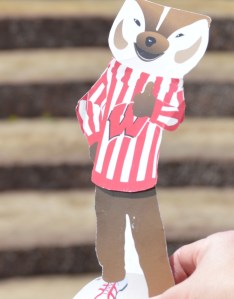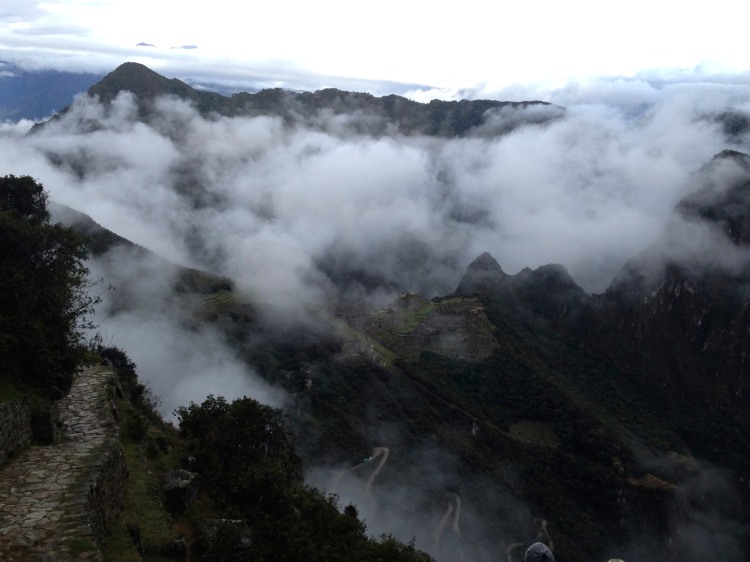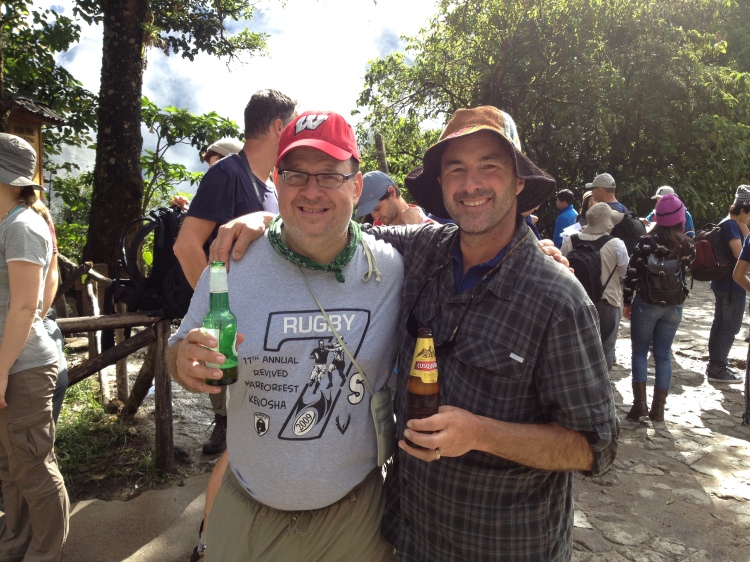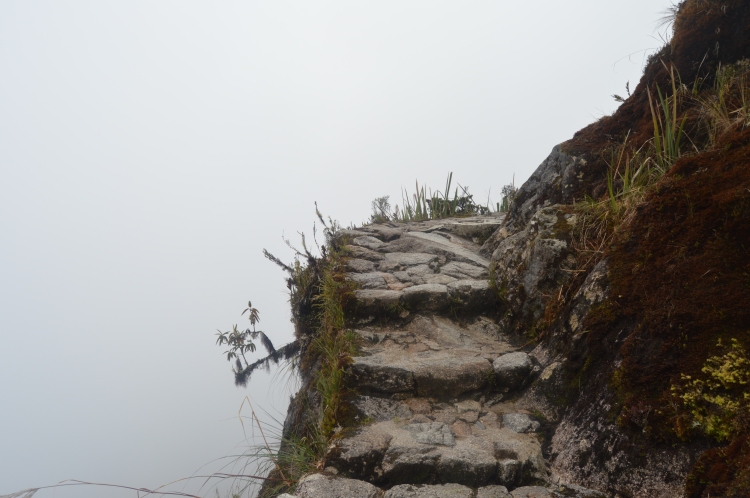Machu Picchu is the most famous Incan site and the mainstay of Peruvian tourism. Built around 1450, it was abandoned in the mid-1500s and was never discovered by the conquering Spanish. Theories abound as to the purpose of Machu Picchu, with the current, most popular one being that the Inca emperor Pachacutec wanted to build his own magnificent capital city instead of ruling from Cusco, the traditional capital of the Incas. Machu Picchu is situated in the Sacred Valley 50 miles (80 kilometers) northwest of Cusco. As one of the 7 New Wonders of the World, it was on our must-see list.

Our first glimpse of Machu Picchu

First view from the Sun Gate

Little lower and the clouds lifted
Our initial decision was how to get there. The most accessible way to see Machu Picchu is to take a train from Cusco to Aguas Calientes and then take the 20 minute ride on the tourist bus to the site. Once there, it is easy to spend a day wandering around the city. The more adventuresome can climb Hauyna Picchu, 1,180 feet above Machu Picchu and a one-hour climb, to get a spectacular view of the entire site and see additional ruins, ascend Machu Picchu Mountain or hike up to the sun gate. So even if one takes the “easy” way to Machu Picchu, there is still plenty of hiking to do on the site itself. But Matt was having none of “easy” and was set on hiking the Inca Trail. Once our friend Carl and his brother Mark decided to join Matt on the trek, I couldn’t wimp out. We chose the most popular 4-day, 3-night hike and after reviewing Trip Advisor and the like selected Peru Treks as our trek company. For $599 a person, Peru Treks outfitted us with tents, sleeping bags and mats, purchased our permits, secured our campsites and provided us with meals and guides for the trek, in addition to a crew of porters who carried all of the gear. Our cost included $60 for the service of a personal porter who in addition to carrying our sleeping mat and bag could carry another 5.5 pounds of personal items for us. Peru Treks sends you back to Cusco via an 1 1/2 hour train ride followed by a 2 hour bus ride. This sounded horrible to me so we opted to book the Peru Rail Vistadome train ourselves and take a 3 1/2 hour train ride and 20 minute cab ride instead. It was the right call as the train was far more comfortable than the bus, and the cost difference was only $45.

4 days later, we would be on that train!
With the planning details out of the way, training and packing became my next concerns. Everything I read indicated that while the hiking is difficult, the hardest part for most people is the altitude. We were taking the orange route, which begins at Kilometer 82.

Trek map
Here is a breakdown of the hike:
Day 1: 7.5 miles (12 km), begin at 8,528 feet (2,600 m) and ascend to 10,137 feet (3,100) for a 1,609-foot (500 m) elevation gain. Touted as the “easy” day of the hike, it wasn’t exactly easy, but not terribly difficult compared to the next two days.
Day 2: 7.5 miles (12 km), begin at 10,137 (3,100 m) and ascend to 13,776 feet (4,215 m) for an elevation gain of 3,639 feet (1,115 m) before a steep descent back to 11,480 feet (3,500 m). This second day is the reputed killer day of the hike. When I was in Lima 2 weeks before the hike, I ran into some folks who had recently completed the hike and they told me horror stories of hiking 11 hours and tears all around. I am happy to report that our group hiked it about 6-7 hours (including snack and lunch breaks) and there were no tears that I am aware of.
Day 3: 9.3 miles (15 km), begin at 11,480 feet (3,500 m), hike up to 12,916 feet (3,950 m) for an elevation gain of 1,436 feet (450 m) before the descent of 3,000 stone steps that is referred to as the “gringo killer” and then additional up and down hiking until the end at 8,829 feet (2,700 m). I found this day to be the hardest. Possibly because I was tired from lack of sleep the prior night and the hard hiking the prior day, but just as likely the fact that when we camped the second night we had a view of the climb that we would immediately begin on Day 3. I think seeing the ascent (and the top of the photo is not the top of the pass, there were about 3 more false passes before one arrived at the pass) demoralized me. But no tears or 11 hour days!

Night 2 Campsite – note the demoralizing trail up the mountain
Day 4: The end is in sight! 3.1 miles (5 km), this is where the trail really feels like a cattle call. We were up around 3:00 in order to break camp early and then rush 15 minutes to stand in line at 4:30 am waiting for the trail to open at 5:30. Once open, it was a mad dash to the sun gate to see the view of Machu Picchu, and then a trek down the mountain to the site.
Matt and I live at around 8,800 feet above sea level, so that gave us a good start on training for the hike. I continued with my walks 4-days a week and Matt with his daily walks to work, and then Matt and I would hike on the weekends. Usually Matt kindly carries my water and jacket for me as I despise carrying a backpack (and it is one of the things that I was advised against doing after my spinal fusion surgery so I routinely invoke the prohibition when I don’t want to carry anything but then chose to think that it refers to heavy backpacks and not a few pounds when I wanted to do this hike), but I even started carrying my own pack to get me accustomed to it. Our last joint training hike was our second trek to Cumbe Mayo, which is also on the Inca trail, is about 7 1/2 miles and is fairly steep with a 3,000 foot elevation gain, so I was feeling as prepared as possible for the hiking part of the trek.

Inca Trail

Success!

Girls going to Grandpa’s house (I asked).

Almost there!

Cumbe Mayo
Then there was packing. For some inexplicable reason, after years of traveling for work and pleasure, I am the world’s worst packer. And this time I was limited to 5.5 POUNDS!!! I read blogs on what to pack and a friend’s friend who had done the hike gave me some good advice. After much paring down, I was hoping that this would be 5.5 pounds:

Not 5.5 Pounds
It wasn’t. Further paring down and I ended up with :
- 1 pair hiking pants
- 1 super lightweight, insect repellent zip up jacket
- 3 pairs of hiking socks
- Fleece pants, long sleeved cotton top and 1 pair of short sport socks to sleep in
- 1 sports bra
- 5 pair of underwear
- 3 short sleeve workout shirts
- Hat/gloves
- Necessary mini-toiletries (no fancy soaps or lotions, here!)

Actual 5.5 pounds
This left me carrying:
- Lightweight (.8 pound) tennis shoes, tied to my pack until Carl pointed out that they were unlikely to weigh our bag on killer Day 2 and I put them in my porter bag instead, along with the notebook/pen, flashlight, scarf and extra wet wipes for the rest of the hike
- Poncho
- Rain Jacket
- Scarf
- Lightweight fleece
- Sunglasses
- Glasses
- Insect repellent, sunscreen, first aid supplies, contacts, hand sanitizer
- Head lamp and mini flashlight
- iPhone
- Wet wipes, toilet paper, Kleenex
- Notebook and pen
- Bandana
- WATER. And water is HEAVY!! 2 liters weighs 4.4 pounds. It always felt so good when I was hiking with only a half liter or so of water left.
So when all was said and done, I carried about 10 pounds. In the end, I packed darn good – with the exception of one pair of underwear, the flashlight and the notepad/pen, I used everything I brought. Matt only had an extra pair of socks and underwear, so he packed well too.
Oh, and these stowaways made it into my pack too!
-

-
Flat Stanley Friend of Kieran Dwyer
-

-
Bucky Badger
Next Up: The Trek Begins!



















































































































